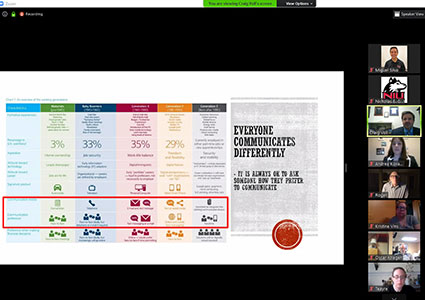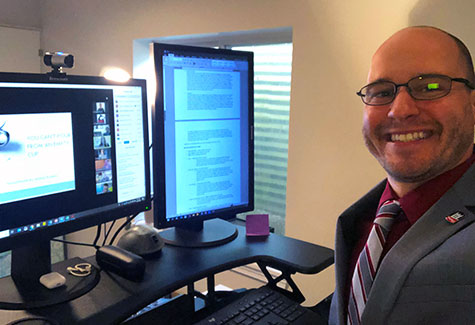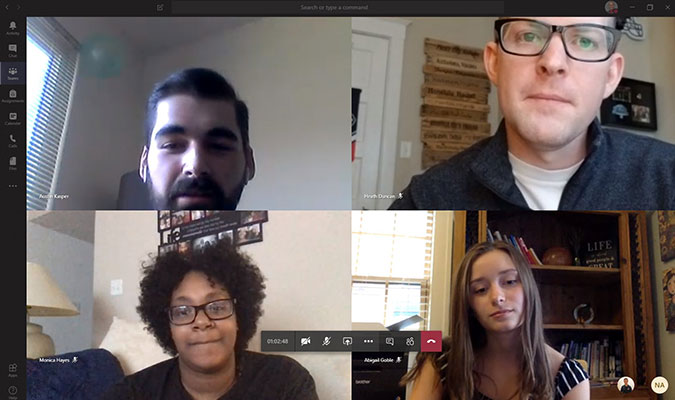
When the arrival of COVID-19 abruptly shuttered life as we knew it, Nicholas E. Grahovec already had most of the pieces in place for the 15th annual Roger and Cathy Kalisiak Lecture Series.
The date. The venue. The keynote speakers. The invitations.
But Grahovec, an assistant professor of (and program director for) Athletic Training, was determined to carry on with the April 30 event.
It was a decision that ultimately quadrupled attendance over a typical year, and one that is likely to draw even larger audiences in the future by offering face-to-face and online participation.
“Right out of the gate, I’m like, ‘Oh, man, we worked so hard,’ and I immediately thought, ‘OK, how can we still make this happen?’ I’ve been part of online webinars for my own continuing education, and I said, ‘I know we can do this,’ ” Grahovec says.
He turned to Todd Gilson, his chair in the Department of Kinesiology and Physical Education.
Gilson “had presumptively purchased a Zoom membership,” Grahovec says, “and that kind of opened the door to opening it beyond just our current students and preceptors.”
As registration for the virtual event quickly approached 100 participants – the limit for Gilson’s basic Zoom subscription – Grahovec approached Gilson again. They used funds donated by Kalisiak, an alum and longtime adjunct instructor and friend of the Athletic Training program, to purchase the next-level package and lift viewer capacity to 500.
Nearly 400 people eventually signed up; 309 actually attended to hear presenters Andrea Kovalsky and Craig Voll, both of whom joined in a tutorial and test-run the day before with Grahovec to prevent any problems.
“It worked with zero glitches and was well-received,” Grahovec says. “Andrea gave her presentation from her home. Craig was in his office. They both delivered them both beautifully.”
Kovalsky, who earned her B.S. in Athletic Training from NIU in 2011 and works as communications director for the Illinois Athletic Trainers Association, spoke on “You Can’t Pour from an Empty Cup: Mental Health for Athletic Trainers.”

Voll, manager of Sports Medicine for Franciscan Health and District 4 director for the National Athletic Trainers Association, addressed “Becoming a Valued Employee.”
“The presenters loved it. They thought it was very easy to do and went really well,” Grahovec says. “They were live and able to take questions.”
Participants were not allowed to unmute themselves, which limited excess noise. Those who wanted to ask questions posted them in the chat box, from which Grahovec would read them aloud.
The chat box also filled with praise not only for Kovalsky and Voll but also for “being able to still hold the event and move it to this capacity so we could entertain a larger audience,” Grahovec says. “I’ve gotten a couple emails over the last week, just more or less congratulating me on a well-run even and thanking me.”
For his part, Grahovec spreads the credit for the event’s online success.
His list starts with Phil Voorhis, the assistant athletic director for Sports Medicine and Athletic Training at NIU and a 1994 alum of the department.
“Phil is very active on social media, whether it be athletic events or program-type events,” Grahovec says. “He’s maintained that networking with alumni. He’s got a huge network of other athletic trainers. There was a huge spike once Phil posted.”
Meanwhile, athletic trainers are hungry for continuing education.
“As a profession, we want to stay on top of the current trends, the current practices in athletic training and the current evidence behind the things we do on a regular basis,” Grahovec says.

“Things have changed dramatically in athletic training over the last 10 years, let alone the last 20 to 30 years,” he adds. “With the increase in the amount of skills that we can do with the changes in our state practice acts, athletic trainers can do a lot more and service a lot more patient populations. We are in a variety of settings: colleges, universities, occupational, public safety, military, performing arts, rehab clinics.”
Of course, timing and circumstances might have played the biggest role.
“It was free,” Grahovec says, “and a perfect storm of events. A lot of athletic trainers have been furloughed over the last several weeks – there were no high school or college athletics – and several were looking forward to this opportunity to knock out some free continuing education while waiting for things to open back up.”


